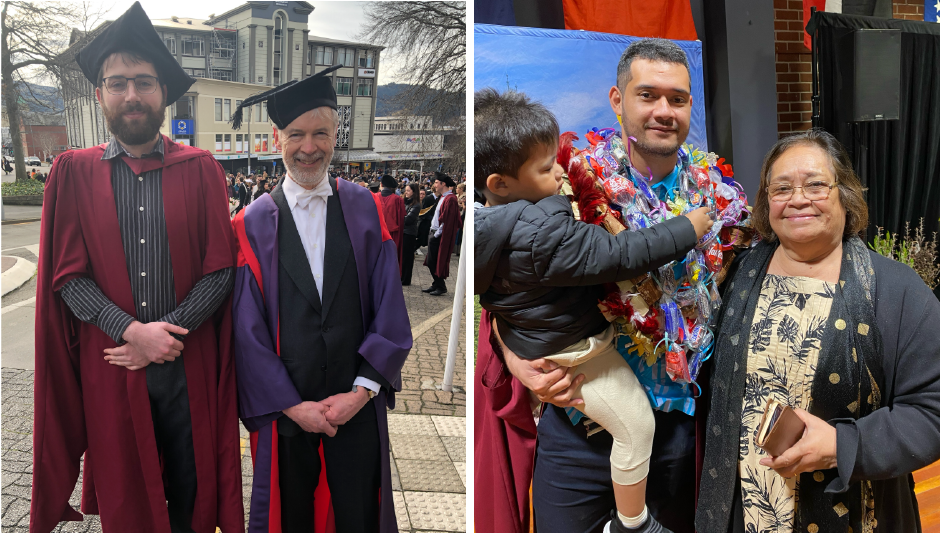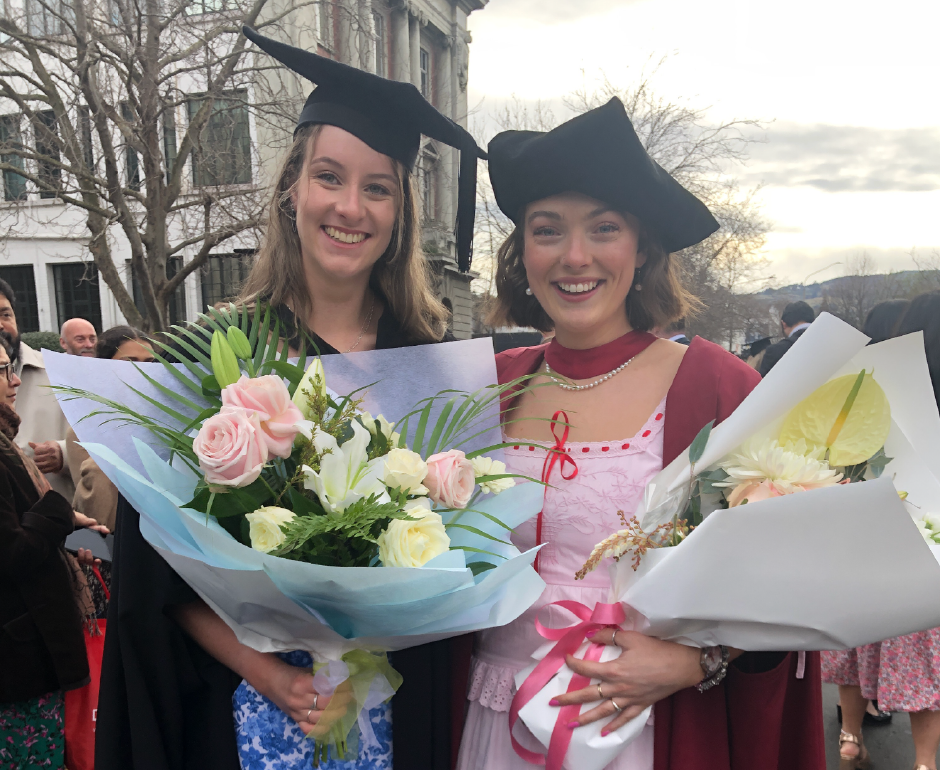
From left, Sarah Barber, Catie Wylie and Cait MacTaggart.
Congratulations to all Department of Biochemistry students graduating this month. Tino pai rawa atu!
Biochemistry graduands August 2024
PhD
Keresoma Leaupepe
Karl Glen
Devon Bull
MSc (Biochemistry)
Sarah Barber
Henru Bornman
Caitriona MacTaggart
Catherine Wylie
MSc (Genetics)
Kate McPhail
BSc
Jacob Lewis
Summer Paulin

Left: Dr Karl Glen stands with Emeritus Professor Iain Lamont. Right: Dr Keresoma MJ Leaupepe stands with family members.
Notes on doctoral graduand theses
Devon Maree Bull, PhD
Development and characterisation of immunocompetent models for metastatic oestrogen receptor positive breast cancer
Approximately 80% of breast cancer diagnoses present as oestrogen receptor-positive (ER+), with ~10% of these patients developing metastatic ER+ breast cancer (mBC). The estimated five-year survival rate of mBC is between 20 – 30% and is effectively incurable with current treatments. Relevant pre-clinical models are required to assess which therapeutic combinations are mostly likely to be effective in mBC. This research aimed to develop a mBC model to be used in future therapy studies. Bioluminescent reporter systems and ER+ breast cancer cells were utilised for the development of the mBC model. Overall, this research has helped gain further understanding of the ways scientists research metastatic ER+ breast cancer and has created a foundation that future breast cancer research can build on.
Karl Anthony Glen, PhD
The genetic basis of beta-lactam resistance in Pseudomonas aeruginosa
This research explored how the bacterium Pseudomonas aeruginosa, a dangerous pathogen, develops resistance to widely used antibiotics called β-lactams. The study found that changes in a protein called PBP3, and the presence of specific enzymes called β-lactamases that degrade the antibiotics, contribute to this resistance. Altering PBP3 increased resistance and also caused changes in cell shape and growth. Multiple β-lactamases reduced the effectiveness of different β-lactam antibiotics. Preventing the bacteria from making these enzymes partially restored antibiotic effectiveness. These findings enhance our understanding of antibiotic resistance mechanisms in Pseudomonas aeruginosa, potentially guiding better treatment strategies.
Keresoma MJ Leaupepe, PhD
Exploring gout in Polynesian populations: Genetic associations and curcumin intervention
Background: Gout, a prevalent inflammatory arthropathy in Māori and Pacific populations, including Samoa, results from hyperuricemia and the formation of monosodium urate crystals. This research encompasses two key aspects of gout management and understanding in these populations: genetic variant associations with gout and the potential efficacy of curcumin, a natural anti-inflammatory agent, in its treatment.
Methods: The genetic component of the study involved 1146 gout cases and 1269 controls from Polynesian ancestry in Aotearoa New Zealand. Low pass whole genome sequencing was utilized to identify Polynesian-specific and rare or novel variants of the ABCG2, PKD2, and IL37 genes. The clinical trial in Samoa, a feasibility study for a larger randomized controlled trial, enrolled 60 gout patients. Participants were randomly assigned to receive either curcumin or placebo capsules over three months, assessing not only curcumin’s efficacy but also feasibility issues including participant adherence, recruitment feasibility, patient willingness to participate, donate body tissues, accept randomization, and the effectiveness of the blinding mechanism. Gout outcome measures were also analysed.
Results: The genetic study identified several Polynesian-specific ABCG2 variants linked with gout and urate, including a significant variant chr4_88107915_C_T, and replicated previous findings of gout-associated variants. The trial in Samoa faced challenges due to the COVID-19 pandemic, leading to significant loss to follow-up. However, it demonstrated successful recruitment and randomization, good patient adherence, and effective blinding despite some issues with missing data. The limited available data suggested a trend towards the efficacy of curcumin in managing gout symptoms, but these results were inconclusive due to the disrupted follow-up.
Conclusion: This study provides valuable insights into the genetic predispositions to gout in Polynesian populations and lays the groundwork for future, more conclusive research on curcumin's role in gout management. The findings from the genetic analysis contribute to a deeper understanding of gout's pathogenesis in these communities, while the preliminary data from the clinical trial in Samoa underline the feasibility of conducting larger-scale randomized controlled trials in this setting, despite the challenges posed by external factors like the COVID-19 pandemic.

From left, Sarah Barber and Dr Devon Bull.